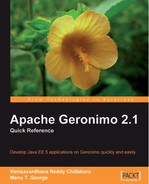What this book covers
Chapter 1: Introduction - This chapter introduces the reader to the Apache Geronimo Application Server, lists the features that it provides, and the steps that the user has to follow in order to download, install, and start the server.
Chapter 2: Architecture - This chapter gives a high-level overview of the Geronimo architecture. It introduces the reader to the concepts of GBeans, Geronimo Plugins, and the different subsystems of Geronimo.
Chapter 3: Database connectivity - This chapter talks about Geronimo's database connectivity features. It lists the databases supported, and explains how to create database pools and establish connectivity with all of the supported databases using Geronimo.
Chapter 4: JMS - This chapter details the messaging features that Geronimo provides, and guides the user through using the bundled JMS provider, ActiveMQ, to create and use JMS resources.
Chapter 5: Java EE Application deployment - This chapter details the installation of different types of Java EE applications and modules and application clients. It guides users through writing deployment plans for these different Java EE artifacts. This chapter also covers the transaction support provided by Geronimo.
Chapter 6: Security - This chapter takes the user through configuring security in order to secure the server environment and the applications running in Geronimo.
Chapter 7: CORBA - This chapter covers configuring the EJBs running in Geronimo so that they are available through CORBA, and also covers configuring remote EJB references to invoke remote EJBs through CORBA.
Chapter 8: JNDI - This chapter describes the different JNDI environments in Geronimo, gives the steps necessary to bind custom resources to JNDI by using GBeans, and shows us how the global JNDI environment can be leveraged for user's applications.
Chapter 9: Plugins - This chapter educates the user in creating and deploying Geronimo plugins, creating custom server assemblies, and extending Administration Console through plugins.
Chapter 10: Administration - This chapter walks the user through the common administration tasks, such as managing server components, application management, monitoring, working with keystores, and GShell.
Chapter 11: Eclipse Plugin - This chapter introduces the Geronimo Eclipse Plugin (GEP) and explains how to obtain and install it. It takes the user through the various features of the GEP and shows how to develop a sample application by using the Geronimo Eclipse Plugin.
Chapter 12: Clustering - This chapter covers how to configure horizontal and vertical clustering using Geronimo, demonstrates web application clustering using WADI, and explains how to configure load balancing by using the Apache Web Server and mod_jk plugin.
Chapter 13: Logging - This chapter covers all of the configurations required for setting up logging for both the server and user applications. It covers logging frameworks such as log4j JUL, and so on, and the SLF4j wrapper that comes with Geronimo.
Chapter 14: Geronimo Internals - This chapter introduces the user to the internals of Geronimo and the low-level services such as kernel, server info, configuration manager, and so on. It takes the user through developing and deploying new services through GBeans.
Appendix-A: Deployment plans - This appendix covers elements common to all Geronimo deployment plans.
Appendix-B: Troubleshooting - This appendix covers troubleshooting server startup, application deployment, application startup, and runtime problems.
